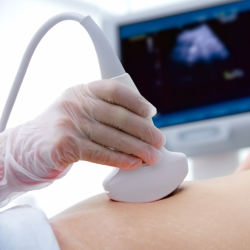Ovarian Cysts
 Overview
Overview
Cysts (fluid-filled sacs) on the ovaries develop monthly as part of the reproductive cycle of females. Two of the most common types of ovarian cysts are corpus luteum and follicular. Both types are classified as functional because of their role in female reproduction. Both of these types of cysts are typically painless and resolve on their own in two or three monthly cycles.
Other types of ovarian cysts include:
- Dermoid cysts - An ovarian cyst filled with cells that produce teeth, hair or other types of tissue.
- Endometriomas - These cysts develop in women who are suffering from endometriosis.
- Cystadenomas - This is a benign cyst that contains water or a mucous-like fluid.
- Polycystic ovaries - When eggs are recruited to develop but do not mature and are not released regularly at ovulation, this condition occurs.
Causes of Ovarian Cysts
Every month an egg bursts from the ovary out of a follicle, which is a cyst-like structure. The process is mediated by luteinizing hormone (LH). An increase in the body's LH level signals the egg to be released. After the egg is released, the follicle turns into a structure called a corpus luteum, which produces progesterone to further prepare the uterus for conception. If conception does not take place, the corpus luteum normally resolves in 14 days.
Prevention
Suppressing ovulation with hormone therapy can decrease a woman's chances of forming ovarian cysts. The complications which are associated with the occurrence of cysts can be reduced by having regular pelvic exams.
Diagnosis
A variety of symptoms can accompany ovarian cysts. These include pain in the abdomen or pelvic area, pain during sexual intercourse, painful menstruation, a feeling of fullness in the abdomen, and pressure on the bladder or rectum.
When ovarian cysts twist and cut off their own blood supply, the resulting condition is called ovarian torsion. This usually causes a sudden onset of severe abdominal pain, vomiting and nausea. Other benign and less common cysts include Brenner's tumors and fibroadenomas. Cancerous cysts can occur, but premenopausal women rarely have a cancerous cyst of the ovary. The risk of ovarian cancer in women is about 1 in 70.
A pelvic examination can provide an accurate diagnosis of ovarian cysts. The doctor can feel the area of the abdomen near the ovaries to help identify any growths. Giving the physician a medical history can help the doctor and patient work together to identify unusual symptoms or changes in menstruation.
Other tests for ovarian cysts can include:
- Pelvic ultrasound - High-frequency sound waves produce an image of the uterus and ovaries.
- Blood test - A blood sample is analyzed to identify elevated amounts of CA 125, a substance frequently found in the body of some women who have ovarian cancer. This test is especially helpful for menopausal women who have an ovarian cyst.
Conventional Treatments
Because many cysts simply resolve on their own, some physicians may choose to only monitor the condition for up to three months.
Birth control pills prevent ovulation, therefore lowering the probability that a new cyst will form.
Surgery is called for in some cases to remove a persistent or very large cyst, to eliminate severe symptoms, or to ensure that a cyst is not cancerous.
Natural Treatments
Because cysts are the result of hormonal imbalance, it is crucial to partake of a diet which balances the hormones. A good diet also aids the body in natural detoxification. Antioxidants can rid the body of free radicals, the unstable atoms that cause abnormal cell growth. This type of cell growth can lead to cell mutation and cancer. Antioxidants are found in leafy green vegetables, citrus fruits, kiwi fruit and green beans.
Supplements
Some of the supplements which can be beneficial in fighting ovarian cysts include:
- B-complex vitamins - B vitamins help to detoxify old estrogen to improve overall hormonal balance.
- Vitamin C - The bioflavanoids are crucial antioxidants, helping to fight free radicals and boosting the immune system.
- Zinc - The body needs zinc to ensure eggs are developing normally in the ovaries. It also helps to protect the body from damage due to free radicals.
Herbs
Some of the herbs that are helpful in treating ovarian cysts are:
- Echinacea - This immunity booster helps improve the number of white blood cells in the body. This herb is more effective when it is not taken continuously. Take it for 10 days, stop for 3 days, and then take it again for 10 days.
- False unicorn root - This herb helps to regulate the body's hormones and the cycle of changes that take place in a woman's ovaries.
- Garlic - Although this is a common cooking herb, garlic has a very protective effect on the body's cells.
- Milk thistle - This herb is a well-known tonic for the liver. It also boosts the body's ability to detoxify. Milk thistle encourages the body to destroy abnormal cells and excrete excess hormones.
Other Natural Treatments
A few other treatments that are effective for ovarian cysts are acupuncture and aromatherapy. Also, avoid the use of talcum powder, stop smoking and avoid the use of alcohol.
References
- Bratman, S. (1998). The Alternative Medicine Ratings Guide: an expert panel rates the best treatments for over 80 conditions. New York: Crown Publishing Group (1998)
- Brown, L. (1999). Alternative Medicine. London : Teach Yourself
- Deepak Chopra, M.D. (2002). Alternative Medicine: The Definitive Guide. Puyallup, Wash. : Future Medicine Pub.
- Duke, J. (2003). The Green Pharmacy: Herbal remedies for common diseases and conditions from the world's foremost authority on healing herbs. London : Rodale
- Servan-Schreiber, D.(2006). The Encyclopedia of New Medicine: Conventional & Alternative Medicine For All Ages. London : Rodale
Posted in Ovarian Cysts
Ask a Question Or Join a Discussion


